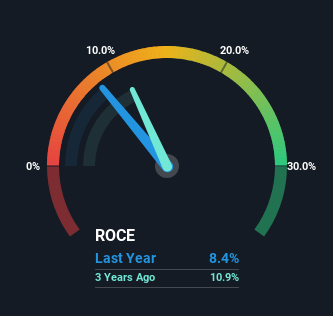- United Kingdom
- /
- Building
- /
- AIM:HSM
Samuel Heath & Sons (LON:HSM) Has More To Do To Multiply In Value Going Forward
To find a multi-bagger stock, what are the underlying trends we should look for in a business? Firstly, we'd want to identify a growing return on capital employed (ROCE) and then alongside that, an ever-increasing base of capital employed. Put simply, these types of businesses are compounding machines, meaning they are continually reinvesting their earnings at ever-higher rates of return. Although, when we looked at Samuel Heath & Sons (LON:HSM), it didn't seem to tick all of these boxes.
What Is Return On Capital Employed (ROCE)?
For those that aren't sure what ROCE is, it measures the amount of pre-tax profits a company can generate from the capital employed in its business. The formula for this calculation on Samuel Heath & Sons is:
Return on Capital Employed = Earnings Before Interest and Tax (EBIT) ÷ (Total Assets - Current Liabilities)
0.084 = UK£990k ÷ (UK£14m - UK£2.4m) (Based on the trailing twelve months to March 2023).
Thus, Samuel Heath & Sons has an ROCE of 8.4%. On its own, that's a low figure but it's around the 9.8% average generated by the Building industry.
View our latest analysis for Samuel Heath & Sons

Historical performance is a great place to start when researching a stock so above you can see the gauge for Samuel Heath & Sons' ROCE against it's prior returns. If you'd like to look at how Samuel Heath & Sons has performed in the past in other metrics, you can view this free graph of past earnings, revenue and cash flow.
So How Is Samuel Heath & Sons' ROCE Trending?
Things have been pretty stable at Samuel Heath & Sons, with its capital employed and returns on that capital staying somewhat the same for the last five years. Businesses with these traits tend to be mature and steady operations because they're past the growth phase. With that in mind, unless investment picks up again in the future, we wouldn't expect Samuel Heath & Sons to be a multi-bagger going forward.
In Conclusion...
In summary, Samuel Heath & Sons isn't compounding its earnings but is generating stable returns on the same amount of capital employed. Unsurprisingly then, the total return to shareholders over the last five years has been flat. All in all, the inherent trends aren't typical of multi-baggers, so if that's what you're after, we think you might have more luck elsewhere.
On a final note, we found 4 warning signs for Samuel Heath & Sons (1 makes us a bit uncomfortable) you should be aware of.
If you want to search for solid companies with great earnings, check out this free list of companies with good balance sheets and impressive returns on equity.
New: Manage All Your Stock Portfolios in One Place
We've created the ultimate portfolio companion for stock investors, and it's free.
• Connect an unlimited number of Portfolios and see your total in one currency
• Be alerted to new Warning Signs or Risks via email or mobile
• Track the Fair Value of your stocks
Have feedback on this article? Concerned about the content? Get in touch with us directly. Alternatively, email editorial-team (at) simplywallst.com.
This article by Simply Wall St is general in nature. We provide commentary based on historical data and analyst forecasts only using an unbiased methodology and our articles are not intended to be financial advice. It does not constitute a recommendation to buy or sell any stock, and does not take account of your objectives, or your financial situation. We aim to bring you long-term focused analysis driven by fundamental data. Note that our analysis may not factor in the latest price-sensitive company announcements or qualitative material. Simply Wall St has no position in any stocks mentioned.
About AIM:HSM
Samuel Heath & Sons
Engages in the manufacture and sale of various products in the builders’ hardware and bathroom field in the United Kingdom.
Flawless balance sheet, good value and pays a dividend.
Market Insights
Community Narratives




